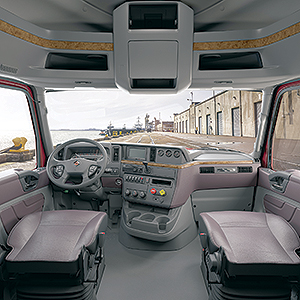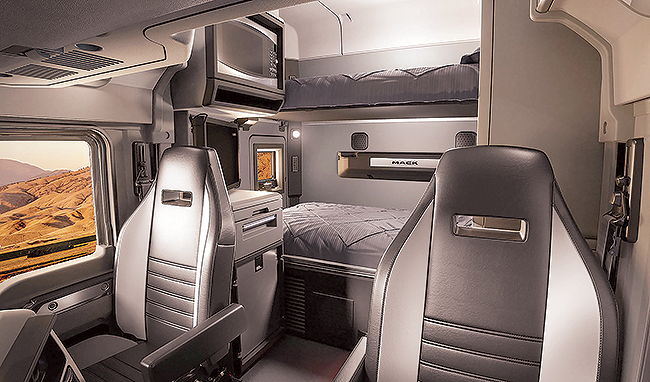Effective Cab Ergonomics Has Key Role in Driver Productivity, Safety and Health, Industry Experts Say

At GP Transco, a trucking company based in Darien, Ill., about 60% of company drivers leave on Sunday or Monday and return on Friday. An additional third are gone for two to three weeks. That’s a long time for any person to spend the majority of a 24-hour day in a small space.
Manufacturers that supply over-the-road trucks, as well as those who operate them, have something to say about their trucks’ cab design. And ergonomics plays a critical role to help enable drivers to perform efficiently.
Jonas Bidva, managing director of GP Transco, said most of the company’s trucks are less than three years old. It almost always buys standard cab options, and drivers have had few issues with them, he said. GP Transco relies on the truck manufacturer to provide cabs that are ergonomically safe and comfortable.

A driver relaxes in his cab. Truck OEMs understand the importance of comfort in cab ergonomics because it's a driver's home while on the road, industry experts say. (EpicVue)
“The biggest issues are the trucks themselves,” he said. “Drivers often prefer one brand of truck over another. Usually, the cab is not an issue.” However, he noted that owner-operators sometimes prefer a better mattress or a certain type of seat.
GP Transco supports driver safety and comfort. Because it renews its fleet assets with new trucks often, the latest ergonomics are expected.
Others, however, are more particular about truck cab ergonomics and are more proactive in feature selection within the cab concerning comfort and safety.
“In the past, cabs weren’t designed to accommodate every driver,” said Nancy Kelly, nurse case manager and Occupational Safety and Health Administration risk management for Averitt Express based in Cookeville, Tenn. “Now, we are seeing more attention being paid to the ergonomics by manufacturers.”
Averitt ranks No. 32 on the Transport Topics Top 100 list of for-hire carriers in North America.
The company’s Freightliner Cascadia sleeper cabs, for example, feature seats, steering wheels and pedals that can adjust to comfortably fit nearly any body type, Kelly said.
“While we may not be able to attribute every reduction in injuries or accidents to ergonomic improvements, we are increasingly seeing the correlation between comfort, safety and even driver retention,” she said.
Nic Signorini, director of supply management for Ryder System Inc., said cab ergonomics play an important role to help reduce driver distraction and fatigue. The Miami-based company also works with equipment manufacturers to help them advance the design and implementation of safety features.
Those include more obvious options such as larger windshields and windows for improved visibility, Signorini said. “Other options that may seem like convenience-only also serve as safety features, such as adjustable tilt and telescoping steering wheels, adjustable seat belts, and movable cup holders.”
“These user-centric controls allow drivers to get what they need with as little effort as possible to avoid distraction and fatigue,” he said.

The interior of an International LT truck by Navistar. The truck maker stresses the human factor in the design of cab components. (Navistar Inc.)
Truck cab ergonomics also can help reduce worker injury due to prolonged sitting and repetitive motion.
Steve Kane, president of Rolling Strong, a Kansas City, Mo.-based company that offers a mobile health and wellness platform, said data show that truck drivers are twice as likely to have an on-the-job injury as opposed to the general workforce.
“Drivers are sedentary for up to 11 hours a day and sleep in less-than-perfect conditions,” Kane said. “As a result, they have skeletal issues and very tight tendons and ligaments. When you add lack of hydration, the tendons and ligaments get dry. This causes issues with proper support of the joints and low back as well as creates higher risk of pulling muscles and needing to support ligaments and tendons.”
“[The company’s program] is aimed at helping drivers stay healthy and avoid other injuries from chronic exposure from repetitive tasks and prolonged bodily positions,” Kane said.
Some insurance companies also emphasize the importance of smartly designed truck cabs to reduce driver injury.
Daniel Grant, director of corporate safety services for Sentry Insurance, said injuries typically are caused from chronic exposures such as repetitive reaching, poor posture, and seat and steering sets not adjusted properly for the individual driver.
“Over time, they start to affect the driver, causing discomfort, pain and impacting overall health,” Grant said. “Good ergonomic design can help reduce these exposures. By making cabs more ergonomically friendly and reducing the likelihood of drivers becoming symptomatic from injuries, fleet managers can keep drivers on the road, reducing the chances [and costs] of long-term injuries while improving productivity.”

A driver exits the cab. Steps for egress and entry are key safety features, experts say. (Averitt Express via YouTube)
Jim Nachtman, product marketing director for on-highway trucks for Navistar Inc., emphasized the human factor design of components. Aspects such as steps for egress and entry to the cab signify the importance of a focus on a much-needed safety feature. He said improved ease of entry and egress from the vehicle is intended to reduce slip-and-fall situations.
Mirror placement can reduce neck strain, he said, and a leather steering wheel allows a more comfortable grip.
Nachtman also discussed the indoor air quality of the cab, which Lisle, Ill.-based Navistar focuses on. Areas include improved door seals, which help provide the driver with a quiet environment, he said.
Mike Padrnos, business development manager for Lippert Components, a firm that makes components for truck cab interiors, said that the many sleeper configurations provide more room in the cab, making it easy for drivers to move about within the sleeper cab area.
According to Padrnos, it’s easy to predict how drivers get into the upper bunk: step on the console ledge, grab a bar, and hoist themselves up onto the bunk platform that rests 5 to 6 feet above the floor.
“With truck drivers’ body types ranging anywhere from short and petite to NFL defensive lineman, this pattern is not always an easy task and can cause a huge strain on the body,” he said. “Getting down each morning can be just as challenging and sometimes dangerous. The possibility of slipping, missing, straining and stretching can contribute to minor or major injuries.”
Like the GP Transco driver who spends vast time on the road in a truck cab, ergonomics is shaping a new paradigm of habitability for truck manufacturers and fleet operators, industry experts said. For today’s drivers, the cab is their world — it’s their everyday environment.

The cab of a Mack Anthem truck. Proper cab design, including ergonomics, provides a comfortable place for drivers when on the road and can help prevent driver injury, Mack Trucks says. (Mack Trucks)
Stu Russoli, highway product manager at Greensboro, N.C.-based Mack Trucks, said that Mack puts much effort into proper cab design, including ergonomics. “Cab ergonomics are an important part of a truck fleet,” he said. “They not only provide an amenable environment for drivers, but they also ensure safety and prevent injury.”
Mack’s cab ergonomics are taken seriously. The OEM, like other truck manufacturers, understands the importance of driver comfort, health and safety as it is their home away from home while driving, Russoli said.
Averitt Express’ Kelly summed up proper truck cab design: “Most people wouldn’t consider how important ergonomic design can be for the well-being of a driver. From the smallest to the largest design enhancements, the changes we are seeing in today’s cabs are making a difference.”

